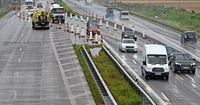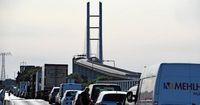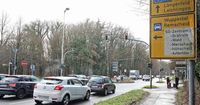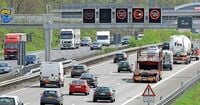On April 16, 2025, traffic congestion is a pressing concern across various regions in Germany, with reports indicating significant delays due to construction and accidents. The MAZ-Staumelder, OZ-Staumelder, RGA-Staumelder, ST-Staumelder, and WAZ-Staumelder have all provided updates on the current traffic situations in their respective areas, highlighting the routes that are experiencing slower-than-usual travel times.
In Havelland, the MAZ-Staumelder reported that traffic is notably sluggish on major routes including the A2, A10, A14, and several federal roads such as B5, B102, and B188. The data is derived from various sources, including cities like Falkensee, Nauen, and Rathenow. The information is provided by TomTom, which claims to utilize GPS data from millions of devices and updates every five minutes to ensure accuracy. This service aims to keep drivers informed about traffic conditions and potential delays.
Meanwhile, in Stralsund and Rügen, the OZ-Staumelder has also indicated that traffic is slower than usual on the A20 and several federal roads including B96, B105, B194, and B196. The same methodology of data collection applies, with TomTom’s extensive database providing the necessary updates to inform local drivers.
In Remscheid, the RGA-Staumelder has identified significant traffic slowdowns on critical routes such as the A1, A46, and various federal and state roads including B51, B51n, B229, B237, B483, L74, L81, L101, and L418. The A1, in particular, has been highlighted as one of the most congested routes in the region, with almost 6,500 hours of traffic jams reported between Cologne and Dortmund in 2023. The A46 is another major route, ranked as the sixth most congested road in North Rhine-Westphalia (NRW), making it essential for commuters in the area.
Solingen is also facing its share of traffic troubles, as indicated by the ST-Staumelder. Key routes such as the A1, A3, and A46 are experiencing delays, with the A3 being the most congested route in NRW, where commuters reportedly spent over 10,000 hours in traffic in 2023. The ongoing construction work on the A3 near Solingen has exacerbated the situation, leading to further frustrations for local drivers.
In Wolfsburg, the WAZ-Staumelder has reported similar issues, with traffic delays on the A2, A39, and several federal roads including B188, B4, B248, and B244. The updates from this region also rely on TomTom’s data, ensuring that drivers have access to real-time information regarding their travel conditions.
Across all these regions, the common thread is the reliance on TomTom’s data collection methods. The company utilizes GPS coordinates from millions of mobile devices and official road sensors, alongside manually maintained information, to ensure the accuracy of the traffic reports. This data is crucial for drivers who need to navigate through congested areas, especially during peak travel times.
As traffic continues to be a significant concern, authorities and traffic services urge drivers to remain patient and considerate towards other road users. With the data being updated every five minutes, commuters are encouraged to stay informed and adjust their travel plans accordingly to avoid the worst of the traffic.
In summary, the current traffic situation in various regions of Germany highlights the challenges faced by commuters due to construction and accidents. With reliable data sources like TomTom providing timely updates, drivers can better navigate the congested roads and make informed decisions about their travel routes. As the situation evolves, staying updated will be key to minimizing delays and ensuring safe travels.








